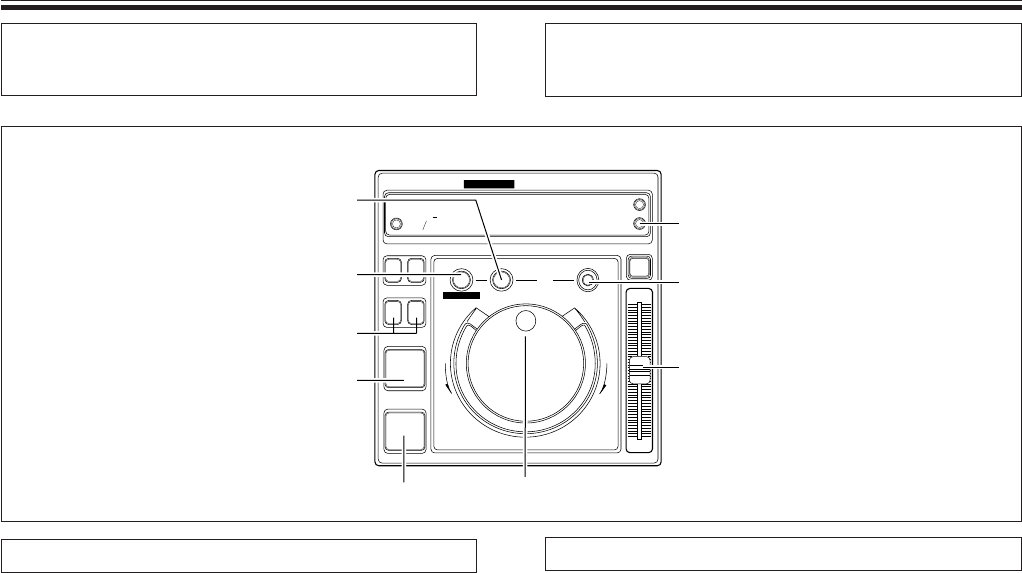
18
<DRB1214>
En/Fr
•
TIME
MODE
AUTO
CUE
TEMPO
±10/±16
MASTER
TEMPO
EJECT
TEMPO
+
FWD
–
REV
PLAY/PAUSE
CUE
SEARCH
TRACK SEARCH
IN/REALTIME CUE OUT/EXIT RELOOP
4¢
1¡
0
6
'
D
CDJ-500S
COMPACT DISC PLAYER
PROFESSIONAL
OUT ADJUST
MASTER
TEMPO
RELOOP
TEMPO
W O_CA
PLAY/ PAUSE
CUE
SEARCH
(1, ¡)
LOOP OUT
/EXIT
LOOP IN/
REAL TIME
CUE/OUT
ADJUST
LOOP
ADVANCED OPERATIONS/DEMARCHES EVOLUEES
Jog Dial Functions
Playback
During playback, rotate the jog dial slowly (two times or
less per second: beat search)
÷ The beat (tempo) changes in proportion to the amount
the dial is rotated, either increasing (FWD+) or decreas-
ing (REV–).
÷ When dial rotation is stopped, the tempo returns to its
original speed.
Rotating the jog dial quickly (more than two times per sec-
ond) during playback.
÷ Fast forward or fast reverse will be performed while
producing broken or intermittent sound from the disc.
Standby (Frame Search)
With the unit in standby mode, rotate the jog dial slowly.
÷ Frame search will be performed in 1-frame increments.
÷ If the dial is rotated at a steady rate in the FWD+ direc-
tion, playback sound will be audible (normal speed).
Cue Standby (Cue Point Adjust)
With the unit in cue standby mode, pressing one of the
SEARCH buttons (1, ¡) causes the unit to enter the
audible standby mode (disc sound can still be heard even
though unit is in standby). Rotating the jog dial moves the
cue point. After moving the cue point, press the CUE but-
ton to set the new cue point.
Loop Play (Loop-Out Point Adjust)
During loop play, press the LOOP OUT ADJUST button to
enter loop out adjust mode. Rotating the jog dial move the
loop out point in 1-frame increments.
SPECIAL DISC JOCKEY
TECHNIQUES
Jog dial/Molette pas-à-pas
TECHNIQUES SPECIALES “DISC
JOCKEY”
Fonctions de la molette pas-à-pas
Pendant la lecture
Rotation lente de la molette (deux fois ou moins par
seconde: recherche à mesure) pendant la lecture
÷ La mesure (tempo) change selon le degré de rotation de
la molette: soit elle augmente (FWD+), soit elle diminue
(REV–).
÷ Quand on arrête de tourner la molette, le tempo revient
à sa vitesse originale.
Rotation rapide de la molette (plus de deux fois par
seconde) pendant la lecture
÷ L’avance rapide ou le recul rapide est exécuté en laissant
entendre les sons brisés ou intermittents du disque.
Pendant l’attente (Recherche d’image)
Pendant que l’appareil est en mode d’attente, tourner
lentement la molette pas-à-pas.
÷ La recherche d’image s’accomplit par palier d’une ima-
ge.
÷ Si la molette est tournée à une cadence régulière dans
le sens avant (FWD+), le son reproduit est audible (vitesse
normale).
Pendant l’attente au point d’attaque (Réglage de
point d’attaque)
L’appareil étant en mode d’attente au point d’attaque, une
poussée sur une des touches SEARCH (1, ¡) le fait
passer au mode d’attente audible (le son du disque est
audible bien que l’appareil soit en attente). La rotation de
la molette déplace le point d’attaque. Après l’avoir fait,
appuyer sur la touche CUE pour définir le nouveau point
d’attaque.
Pendant une lecture en boucle (Réglage du point
de sortie de boucle)
Pendant la lecture en boucle, appuyer sur la touche LOOP
OUT ADJUST pour passer au mode de réglage de sortie
de boucle. Une rotation de la molette permet alors de
déplacer le point de sortie de boucle par paliers d’une ima-
ge.


















